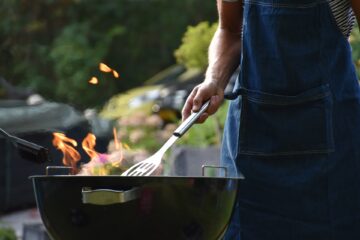Barley is a versatile and nutritious cereal grain that is commonly used in many different types of dishes, from hearty soups and stews to light and refreshing salads. One important aspect of cooking with barley is understanding how much it expands when cooked. This information is particularly useful for meal planning and portion control, as well as ensuring that your barley dishes turn out just right. In this article, we will delve into the science behind barley expansion and explore the different factors that can affect it. We’ll also discuss tips for cooking barley to achieve optimal results, and offer suggestions for incorporating it into your favorite recipes. Whether you’re a seasoned home cook or a newbie in the kitchen, this article will provide you with the knowledge you need to cook delicious and nutritious barley dishes with confidence.
What is Barley?
Barley is a cereal grain that has been cultivated for thousands of years and is used in many different cuisines around the world. It is a good source of fiber, protein, vitamins, and minerals, and has a nutty, slightly sweet flavor that works well in a variety of dishes.
There are several different types of barley, including hulled barley, pearled barley, and quick-cooking barley. Hulled barley is the least processed type and retains its outer hull, which makes it more nutritious but also takes longer to cook. Pearled barley, on the other hand, has had its outer hull removed and has been polished to remove some of the bran layer, making it quicker to cook but less nutritious than hulled barley. Quick-cooking barley is a type of pearled barley that has been partially cooked and dried, which reduces its cooking time even further.
Barley is a versatile ingredient that can be used in a wide range of dishes, from soups and stews to salads and pilafs. Its texture and flavor can add depth and complexity to a dish, and it pairs well with a variety of other ingredients. Whether you’re a fan of hearty, warming dishes or lighter, refreshing salads, barley is a great ingredient to have in your pantry.
Understanding Barley Expansion
When cooking with barley, it’s important to understand how much it expands when cooked. Barley grains absorb water during the cooking process, which causes them to swell and become softer. The amount of expansion depends on several factors, including the type of barley, the cooking method, and the cooking time.
Hulled barley, for example, will expand more than pearled barley because it retains its outer hull, which requires more water and time to cook. Quick-cooking barley, on the other hand, will expand less than pearled barley because it has already been partially cooked and dried.
The cooking method can also affect how much barley expands. Boiling barley in a large pot of water will cause it to expand more than cooking it in a smaller amount of water, as the grains have more space to absorb water. Similarly, cooking barley in a pressure cooker or slow cooker can result in different levels of expansion compared to boiling it on the stove.
Cooking time is another important factor to consider when it comes to barley expansion. Overcooking barley can cause it to become mushy and lose its shape, while undercooking it can result in hard, chewy grains. Finding the right balance between cooking time and expansion is key to achieving the desired texture and flavor in your barley dishes.
By understanding the factors that affect barley expansion, you can adjust your cooking methods and techniques to achieve the desired texture and consistency in your dishes. Whether you prefer your barley grains plump and tender or chewy and al dente, a little bit of experimentation and practice can help you perfect your cooking technique.
How Much Does Barley Expand When Cooked?
The amount of expansion that barley undergoes when cooked varies depending on the type of barley and the cooking method used. In general, barley grains can expand by two to three times their original size when fully cooked.
Hulled barley, which is less processed than pearled barley, tends to expand more during cooking as it retains its outer hull. Hulled barley can expand up to three times its original size when fully cooked. On the other hand, pearled barley, which has had its outer hull removed, expands less than hulled barley and can increase in size by up to two times its original size when cooked.
Quick-cooking barley, which has been pre-cooked and then dried, tends to expand less than other types of barley. Quick-cooking barley can expand up to 1.5 times its original size when cooked.
The amount of expansion can also depend on the cooking method used. Cooking barley in a pressure cooker or slow cooker can result in less expansion than boiling it on the stove, as the pressure and heat can affect the absorption of water by the grains.
Overall, it’s important to keep in mind that the amount of expansion that barley undergoes when cooked can vary depending on several factors. To achieve the desired texture and consistency in your barley dishes, it’s recommended to follow cooking instructions carefully and experiment with different cooking methods to find what works best for you.
Tips for Cooking Barley
Cooking barley is relatively easy and straightforward, and here are some tips to ensure that your barley dishes turn out perfectly:
- Rinse barley before cooking: Rinse your barley grains with cold water to remove any dust, debris, or unwanted particles. This step is essential, especially if you’re using whole barley grains.
- Soak barley overnight: Soaking barley overnight can help reduce the cooking time and make it easier for the grains to absorb water. This is particularly useful when using hulled barley, which can take longer to cook.
- Choose the right cooking method: The cooking method you choose can affect the texture and flavor of your barley dishes. Boiling is the most common method, but you can also try using a pressure cooker or slow cooker for a different taste and texture.
- Use the correct ratio of water to barley: The amount of water you use when cooking barley depends on the type of barley and the cooking method. Generally, the ratio is two parts water to one part barley.
- Season as desired: Barley has a mild flavor and can be seasoned with various herbs and spices to enhance its taste. You can also use broth instead of water for a more flavorful dish.
- Monitor cooking time: Different types of barley require different cooking times, so it’s essential to monitor your barley closely as it cooks. Generally, hulled barley takes around 60 minutes to cook, while pearl barley takes about 45 minutes.
- Let the barley rest: Once the barley is fully cooked, remove it from heat and let it rest for 10-15 minutes before serving. This allows the grains to absorb any remaining water and achieve a more consistent texture.
By following these tips, you can ensure that your barley dishes turn out delicious and perfectly cooked every time.
Conclusion
In conclusion, knowing how much barley expands when cooked can be useful in determining the correct amount to use in your recipes. Barley can expand up to three times its original size when cooked, making it an economical and filling ingredient in many dishes. However, the type of barley you use, the cooking method, and the amount of water you use can all affect the expansion rate.
By understanding how barley expands and following the tips for cooking barley, you can create a delicious and healthy dish that is perfect for any meal. Whether you’re making a hearty soup, a nutritious salad, or a flavorful side dish, barley is a versatile and nutritious ingredient that is sure to please. So, next time you cook with barley, keep in mind its expansion rate, and adjust your recipe accordingly for perfect results every time.





